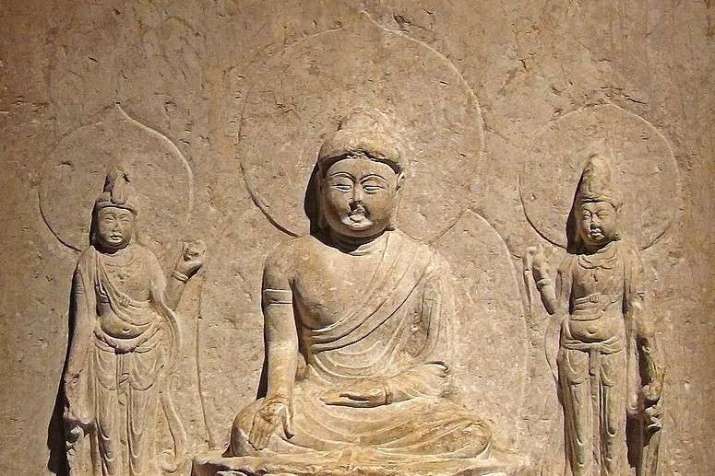FEATURES|COLUMNS|Teachings of Amitabha
The Loss of Pure Land Scriptures in the Late Tang Dharma-Persecution
 Tang-era Buddhist stele, c. 828 CE. From wikipedia.org
Tang-era Buddhist stele, c. 828 CE. From wikipedia.orgThe meaning of a Buddhist school
Master Kuiji (632–82) of the Tang dynasty (618–907) defined the meaning of a Buddhist school in three words: esteemed, lofty, and primary. These can be extended to include the following characteristics:
1. Uniquely honoured: among all the Buddha’s teachings, a school can esteem a certain set of teachings above all others.
2. All-embracing: among all the Buddha’s teachings, a school can embrace within it the thought systems of all other teachings.
3. Singular and surpassing: among all the Buddha’s teachings, a school can play the primary role of leading all the other teachings, like a master.
In this exegesis, the Pure Land school, as one of the largest Buddhist schools in China, is supposed to honor a single set of teachings as “primary.” In this way it should be master to all other Buddhist schools (Chan, Tientai, Huayan, and so on) to the point that they cannot be its equal.
The Pure Land school is also supposed to be able to integrate or incorporate all the doctrinal teachings of other Buddhist schools into its own Pure Land teaching. A complete and coherent system of teaching and practice is essential to maintain the Pure Land school’s unique and unsurpassed esteem among all the Buddha’s teachings.
The almost-perfect process of inaugurating the Pure Land school in China
In the previous two articles in this column, we discussed the inauguration of the Pure Land school by Master Shandao (613–81) in China, a great milestone in the historical development of the Pure Land teaching in Buddhism. This was the full blossoming of Amitabha’s teaching of deliverance through his Fundamental Vow in the lineage pioneered by Nagarjuna Bodhisattva of India (c. 320–400), and followed by Master Tanluan (476–542) and Master Daochuo (562–645).
Apart from patriarchal transmission within the lineage, there is also a transmission of the lifeline of the Pure Land teaching. This is Amitabha’s teaching of deliverance through his Fundamental Vow, which is the Proper Dharma elucidated in the three Pure Land sutras spoken by Shakyamuni Buddha.
Master Shandao was the de facto founder of the Pure Land school who synthesized the strands of Pure Land thought and compiled the Five Works in Nine Fascicles. These writings formulated a comprehensive system of teaching and practice in the Pure Land tradition.
Thus, the Pure Land school has formulated its own comprehensive doctrines, its own name, its own Dharma classification and interpretation, and its own set of core scriptures—which are the key elements constituting a Buddhist school.
A serious blow to the development of Buddhism in China
Unfortunately, there was a serious blow to the development of Buddhism in the late Tang dynasty, known as the “Huichang Dharma-Persecution.” Emperor Wuzong (814–46), who favoured Daoism, ordered the extermination of Buddhism. Buddhist monasteries, scriptures, and images were destroyed en masse. In addition, monks and nuns were forced to resume a secular life.
Perhaps most significantly, many commentaries and texts written by the patriarchs of various schools of Buddhism were lost for good. Though Master Shandao’s Five Works in Nine Fascicles were preserved in Japan and eventually made their way back to China, it took more than a thousand years for this work to return to China.
What happened to the Pure Land school in the Song and Ming dynasties in the absence of Master Shnadao’s works? The simple answer is that the meaning and characteristics of the school as defined above were lost!
An independent Pure Land school becomes an affiliated school in the Song and Ming dynasties
Without referring to Master Shandao’s definitive systematization of the Pure Land teaching, the masters of the Song and Ming dynasties could not honor a single set of teaching as “primary,” and master all other Buddhist schools. They failed to interpret the complete Pure Land teaching according to the three Pure Land sutras, the “primary” scriptures of the Pure Land school.
The main reason was that these patriarchs could not clearly perceive that the lifeline of the Pure Land teaching is Amitabha’s deliverance through his Fundamental Vow, as identified by Nagarjuna Bodhisattva. Likewise, they failed to understand that the substance of the entire Pure Land teaching is the “Name”, as stated by Master Tanluan in the Sui dynasty.
Thus, they failed to embrace the thought systems and teachings of other schools within the Pure Land school. Instead, the opposite happened: the “other-school” patriarchs interpreted the Pure Land teaching with their own “other-school” teachings. As a result, the unique and unsurpassed esteem of the Pure Land teachings was not maintained.
The importance of following the lineage’s transmission
For more than a thousand years, the Pure Land school was not regarded as an independent school, but was an adjunct practice within other Buddhist schools. Known only as an “affiliated school,” this was the “Dark Age” of the Pure Land school in China.
The development of the Pure Land school in Japan was different. The lineage (in terms of lifeline transmission, rather than merely patriarchal transmission) continued with Master Honen (1133–1211) who composed the Collection on Choosing Buddha-recitation According to the Fundamental Vow, and founded the Pure Land school of Japan, based on the Pure Land teachings in the Shandao tradition.
Comparing and contrasting the historical development of these two countries, we cannot help but note the importance of following the lineage in study, practice, and dissemination of the Pure Land teaching, in order to attain 100 per cent assured rebirth in Amitabha’s Land of Bliss in this lifetime.
Related features from Buddhistdoor Global
The Pure Land Lineage from Shakyamuni Buddha to Master Shandao
Pure Land Teaching and the Pure Land School
Three Deficiencies in Faith Leading to Non-exclusive Practice of Name-recitation














